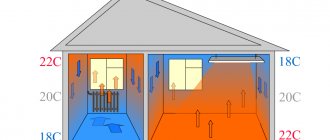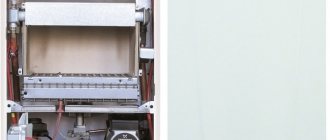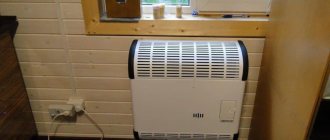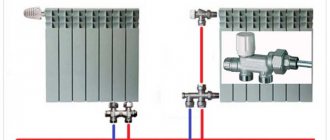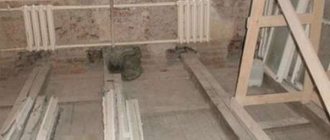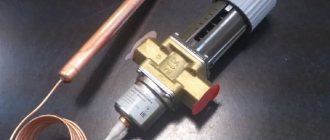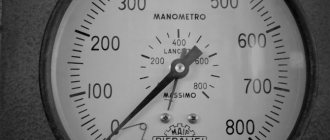Heating a living space is a pressing problem during the cold season. When centralized heating is insufficient or absent altogether, electric convectors help create comfort at home or in the country.
Photo: koreaphone.ru
These efficient heating devices are reliable and functional; they are able to warm up the air in a room in a short time, take up little space, are easy to use, and are equipped with useful functionality. You can use an electric convector wherever there is an outlet.
Depending on the design of the heating element, the following types of devices are distinguished:
- Spiral.
- Tubular (heating elements).
- Needle-shaped.
- Monolithic.
When choosing a heating device, you should pay attention to the following parameters:
- Power.
The rate of air heating directly depends on it. Typically, the following formula is used to calculate this indicator: for rooms with an area of 10 square meters, a device with a power of 1000 W is required. - Control method.
The device can be controlled electronically or mechanically. - Installation.
Heating devices can be floor-mounted, wall-mounted or built into the floor. - Additional functionality.
To ensure safety and ease of control, manufacturers have created the following: automatic shutdown timer, protection against child intervention, overheating, tipping over, anti-icing function, etc.
We present the rating of electric convectors for home and garden 2021. The best 16 models that were selected by our experts based on user reviews and ratings.
| Rating (2021) | Prices, ₽ | A country |
| The best electric convectors for areas up to 15 sq.m. | ||
| 1. Nobo NFK 4W 10 | from 9500₽ | Ireland |
| 2. Electrolux ECH/AS-1000 MR | from 3500₽ | Russia |
| 3. Xiaomi SmartMi Electric Heater 1S (DNQZNB05ZM) | from 8500₽ | China |
| 4. Ballu Camino Eco Turbo BEC/EMT-1000 | from 2900₽ | Russia |
| 5. Hyundai H-HV16-10-UI620 | from 2600₽ | China |
| 6.Edisson Polo 1500M | from 2000₽ | China |
| The best electric convectors for areas up to 25 sq.m. | ||
| 1. Electrolux ECH/AS-2000 MR | from 5500₽ | Russia |
| 2. Xiaomi Mi Smart Space Heater S KRDNQ03ZM | from 7800₽ | China |
| 3. Thermor Evidence 3 Elec 1500 | from 4400₽ | Ukraine |
| 4. Resanta OK-2500SN | from 4700₽ | China |
| 5. Thermex Pronto 1500M | from 2600₽ | China |
| The best electric convectors for areas up to 40 sq.m. | ||
| 1. Electrolux ECH/R-2500 T | from 7800₽ | Russia |
| 2. Nobo NFK 4S 20 | from 14500₽ | Ireland |
| 3. Stiebel Eltron CNS 250 S | from 17000₽ | China |
| 4. Ballu Camino Eco Turbo BEC/EMT-2500 | from 5000₽ | China |
| 5. Ballu BEC/EVU-2500 | from 5800₽ | China |
Heating using a convector
Sometimes it is not advisable to install major heating in a house due to the high cost of funds.
Investments are required for the purchase of equipment, pipes, and a device for removing combustion products. The work of specialists also costs a lot of money. To heat your home you need to purchase fuel every year. In order not to spend money on short-term heating of the house, the owners found an economical solution in the form of using electric heating convectors for heating.
Not only private sector owners are showing interest in heating systems with electric convectors, but also residents of apartment buildings are purchasing devices for additional heating in the winter.
Residents of Europe, Asia and our country are increasingly using electric convectors to create heat indoors, because in some conditions convectors are the only way for a person not to freeze in the cold.
Heating with an electric convector, according to consumer reviews, allows you to provide high-quality heating , but spend decent amounts of money from the family budget, because the price of electrical energy is not low.
Electric convectors are considered as an option for temporary heating or heating for the main heating system. Preference is given to this type even if it is not possible to install another type of heating.
If you calculate all the costs incurred for the installation and maintenance of capital heating and compare them with the costs of paying for the electricity consumed by the convector, you can come to the logical conclusion that heating with electric convectors becomes an acceptable method.
When using electric convectors to heat rooms, these devices must meet the following requirements:
- The device must be equipped with a monolithic tubular-type heating element.
- The electrical device must be equipped with a temperature controller with an electronic system to protect the Prior from overheating.
- It is mandatory to have an automatic button to stop operation if the convector falls.
- It is advisable to install the heater not only on the floor, but also to hang it on the wall, for which purpose the housing design must provide for appropriate fastening.
Wall backing material
The main requirement in finishing walls, floors and ceilings is fire protection. For this purpose, a special substrate is used for a gas boiler in a wooden house. It should not support the combustion process and protect the walls from temperature effects.
Recommended backing material:
- Basalt wool. A layer with a thickness of 50 mm or more is installed on a rigid base (metal sheet). The density of wool is maximum.
- Basalt fireproof sheets. In the event of an open flame, they will protect the wooden surface of the walls from thermal effects.
It is prohibited to use polymeric materials – polypropylene, polystyrene foam
For floor-standing models, special attention is paid to preparing the floor surface. It is leveled, fire-resistant material is installed
In this case, basalt wool is not recommended, as it will shrink under the weight of the boiler. The solution is to install basalt sheets.
Pros and cons of devices
According to customer reviews, using devices for heating a home has a number of undeniable advantages:
- to start heating activities, you just need to buy the device in a store and connect it to the power system; you don’t need to issue any permits;
- does not require periodic maintenance and repair to maintain in working order, operation of the device is simple and accessible to everyone;
- the devices operate quietly and do not disturb the silence, only the clicks of automatic mode switching are heard, which in terms of volume are not always perceptible to the ear;
- after turning on the device, the air in the room very quickly gains temperature, after half an hour we can already talk about the onset of comfortable conditions;
- according to consumer reviews, significant cost savings are observed after choosing the optimal heating mode, which is set using modern temperature controllers;
- low price of purchase, connection and consumption of the device, compared with other types of heating;
- electric convectors with closed heating elements do not dry out the surrounding atmosphere, oxygen in the air is not burned off;
- heating the elements does not lead to the release of harmful substances and poisonous gases;
- When operating in automatic - economical mode, the service life of an electric convector is determined to be a couple of decades.
Like any heating device, an electric convector will consume less material for operation if high-quality insulation of the building envelope is carried out.
Heating with electric convectors has a number of disadvantages:
- Reviews say that with constant intensive heating of the house with convectors, each heating month you have to pay significant amounts for heating.
- Cooling of the room occurs as quickly as heating, which is explained by the low inertia of the device.
- Sometimes it is impossible to connect to a power source in the house due to the low power of the wiring.
- To install software for more economical use of the device, the purchase of additional electronic equipment is required.
The principle of using a convector
The heating effect of the convector is carried out by passing cold air masses through the heating element to increase the temperature.
The heated air, in accordance with physical law, rises and mixes with the atmosphere of the room, heating it. A fan installed in the convector improves the circulation of air masses and speeds up the heating process .
ceramic heating element has high resistance and actively contributes to increasing the temperature in the room.
Trench convector Mohlenhoff WSK 320-190-4500 with natural convection
Photo: https://beru.ru
The Mohlenhoff WSK 320-190-4500 trench convector is an excellent option for houses with a large area, as well as for apartments with high ceilings. The heater operates on the principle of natural convection, due to which cold air is shielded.
Trench convector Mohlenhoff WSK 320-190-4500 with natural convection
Advantages:
- no condensation or fogging of surfaces
- rapid room heating
- fully built-in model, closed with a grille
- suitable for transitional seasonal periods
Flaws:
- high price
Types of convectors by installation method
Electric convectors for heating are divided into the following types : wall convectors;
convectors on the floor; appliances operating in floor niches; devices built into the baseboard. Wall-mounted appliances have more power compared to other appliances. They do not take up floor space, so they are easy to use. The disadvantages of this placement option include the fact that warm air does not fall down, but tends to the ceiling, and the floor remains cold.
Floor-standing types of appliances, although they are produced with less power, but due to their location near the floor surface, heat the room much faster. Convenient is the ability to move to different points, which cannot be done with a permanently mounted electric wall convector.
The installation of small-sized electric heating devices in floor niches significantly saves space in small rooms. In recent years, such placement has been very popular, although it requires preliminary work.
Skirting types of convectors have won positive reviews . Their power is small, but to increase the flow of warm air, some users buy two or more devices, which equates to the energy consumption of a large device.
Different types of thermostats
These devices are designed to control the switching on of the convector and the end of its operation in accordance with the required mode of heating the room.
The temperature regulator is adjusted so that if there are no residents in the house, the room is heated in a gentle mode and does not require unnecessary consumption of electrical energy. By time, you can set a mode when the switching on occurs automatically with the return of household members.
Temperature regulators can be mechanical or electronic . The first type significantly reduces the price of the device, but is not very convenient in terms of comfort. It cannot fully monitor the temperature regime; sometimes it allows, albeit minimal, additional waste of electricity.
In addition, switching is accompanied by quiet sounds, which at night can cause trouble for a sleeping person.
An electronic device has an undeniable advantage in terms of quality of work, but is inferior in price to a mechanical device. It is reliable in operation and has zero indicator errors.
Such devices are equipped with remote control and support various modes of presence and absence of residents. Absolutely silent in operation. Expensive in price, but comfortable use pays for all costs.
Electricity consumption calculation
Agree that it is one thing to make a one-time purchase, and another to pay electricity bills. We emphasize that the calculation was carried out based on operating experience, provided that the house was not cold, like in a freezer, and the temperature was raised to a comfortable level. Let's take a room with an area of 18 m2 as a basis. The technical characteristics of each manufacturer recommend buying a convector with a power of 1 kW for such an area.
It should be clarified that in order to start central heating, the municipal authorities are guided by decree No. 354 dated 05/06/2011, according to which the street temperature must be below +8 degrees and not increase for 5 days. But as a rule, it takes weeks or even months to connect heating at low temperatures.
Plug in the electric heating convector and set the temperature on the thermostat to a comfortable +22. Do not go into calculations, since everything has been checked more than once. With doors and windows closed, at full power from +17 to +22 degrees, a 1 kW convector will operate for 25 minutes.
When the set value is reached, the temperature sensor will trigger and the convector will turn on again. Taking into account the fact that the next heating the starting point will be +20 degrees, and not +17, it will take no more than 10 minutes. After this, the “on-off” cycle will be repeated and the average heater operation will not exceed 20 minutes per hour.
Based on these data, electrical energy consumption can be calculated. Divide 1 kW (1000 W) by 60 minutes and you get 16 W consumption per minute. In the experiment, the convector worked for about 20 minutes. Now we multiply 16 W by 20 minutes of work and get the value of electrical energy consumed per hour - 330 W. For three hours of cyclic operation of the convector, only 1 kW will be used, and it costs 4 rubles.
After coming home, you will need no more than 9 hours of operation of the device - 12 rubles, and a whole month of such pleasure will cost .. 360 rubles. To be on the safe side, add another 30% here, and the total amount will be from 400 to 500 rubles per month. No more than you spend on Internet bills per month, right? As you can see, this is not that expensive and will help protect yourself from ARVI, which costs more than a month of warming up the apartment.
Construction of electrical conversion devices
Heating elements are:
- Like a pipe with aluminum ribs.
- Needle type.
- Monolithic heaters.
In a tubular heater, a nichrome filament is placed in a steel tube. The cavity between the thread and the walls is filled with a material with high thermal conductivity. Aluminum fins on the pipe enhance air movement and provide heat transfer. It is an economical type of heating element, as it heats up more slowly than others and is much lower in temperature.
Many modern models of convectors are equipped with protection against water ingress , which makes it possible to install them in a bath or shower room. Due to the unequal coefficient of expansion when heating aluminum and the tube material, they crack a little during operation.
Needle heaters are made like a dielectric plate, on both sides of which there are heating chrome and nickel filaments. They are treated with a layer of varnish. Such elements operate silently, since the plate and threads heat up and expand in the same mode.
Needle elements are produced only for dry rooms, since they do not provide protection against moisture. Types of needle convectors are short-lived and impractical , they are produced much less frequently and are not in demand among users.
Monolithic and tubular types are deservedly popular due to their efficient and silent operation.
Content:
1. Convector ADAX VP 1020 KT
2. Floor convector Minib PMW165-2250 with natural convection
3. Trench convector Mohlenhoff WSK 320-190-4500 with natural convection
4. Convector Noirot Spot E-5 15000
5. Convector Noirot Spot E-3 Plus 1500
6. In-floor water convector Techno Vent KVZV 250/85/1800 with forced convection
7. Trench convector Techno series Vent KVZV 250/85/1100 with forced convection
8. Convector Resanta OK-2000S
9. Convector Resanta OK-2000
10. Convector Thermor Evidence 3 Elec 1000
Electric convector device
A heating element of one of the above types is mounted in a closed heat exchange chamber .
The material of the heat exchanger walls promotes the rapid spread of heat in the surrounding air. All this is combined in one frame, which has decorative finishing and options for mounting on the floor and on the wall.
The housing is equipped with lattice windows to supply warm air into the room, and the housing casing is made with air layers that prevent burns when touching the housing.
The front part of the housing is used to locate buttons for controlling the actions of the convector. Electric convectors with a fan are noisy and cannot boast of quiet operation.
Reviews
When you read the reviews, you will be convinced that this equipment is really effective, since the reviews are almost all positive.
Alina, 30 years old, Stakhanov
My husband and I bought a dacha, but for heating there was only a strangely designed stove that needed to be heated with wood. There is no gas in the village, so there were problems. We didn’t even consider an electric boiler and radiators - it’s too expensive, so we bought wall-mounted electric heating convectors with a thermostat. For the room we have 2 kW devices, and for the kitchen 1 kW. The quality of heating suits me - not hot and not cold. Moreover, we don’t need to worry like others that the pipes may freeze, since there simply aren’t any. The costs came to 7 thousand, and this, I think, is quite a bit.
Stove heating device in a private house: design of modern stoves
The main structural elements in a stove heating device for a private house are: foundation, trenches, ash chamber, firebox, smoke channels (smoke circuits), chimneys.
The foundation is the base of the stove, which takes on the loads from the stove and chimneys. This structural element must be reliable, since the safety of the structure in use depends on its strength. Correct placement of the stove foundation requires its location to be separate from the foundation of the house. The minimum gap between them is 3 cm, which is filled with sand.
First of all, they dig a well, which is then filled with small fragments of stone or baked brick, after which everything is carefully compacted. In this way, a pillow is prepared for the foundation. Then liquid cement mortar is poured into the pit. Laying a brick or stone foundation is done with bandaging of the seams. The last layer of cement mortar is carefully leveled.
After erecting the foundation, they begin to construct such a structural element of the furnace as shale. They are rows of brickwork that raise the oven on top of the foundation. To install the slates, two or three rows of brickwork are made. The bottom of the furnace is thus also involved in heat transfer.
An element of the design of heating furnaces, such as a blower, or ash chamber, serves to supply air to the firebox and to accumulate the ash coming from it. A special grate in the form of cast iron or steel rods is installed between the firebox and the ash chamber. While the stove is operating, the chamber door should be open, and at the end of the fire it should be closed to avoid rapid cooling of the air inside the stove.
The firebox in heating stoves is a furnace chamber in which fuel is burned - wood and coal. A special hole is installed in the upper part of the firebox to remove flue gas. The dimensions of the chamber are selected in such a way that it is possible to load into the furnace the amount of fuel necessary to heat the furnace.
At the bottom of the firebox, slopes to the grate are arranged, ensuring the free movement of ash into the ash pit. To prevent coals and ash from falling out of the combustion chamber, its door is installed above the grate by one row of brickwork. You can extend the life of the firebox by lining it with refractory bricks.
The operating principle of a stove heating system in a private home is based on heat intake through smoke channels, or smoke circulations. They can be positioned both vertically and horizontally, as well as rise and fall. How efficiently a stove operates depends on the size of the smoke ducts and their location.
The flue gas, passing through the channel, gives off energy in the form of heat to the walls, which heat the furnace. In order to increase heat transfer, smoke channels are designed in such a way that they are long and often change direction.
The smoke ducts of a modern stove heating of a private house can have a cross-section of 13 x 13, 13 x 26, 26 x 26 cm, their walls are made smooth (they are not plastered, since if the plaster is destroyed, the channels may become clogged). Access to the smoke circuits for cleaning them from soot is provided through special doors.
To obtain draft that helps remove gases from burned fuel, a chimney is installed, which is placed outside the house - on the roof. Most often it is made with a round cross-section, since gas movement in pipes with corners is somewhat difficult. In addition, round pipes are easier to clean. Ceramic or asbestos-cement pipes are used as the material for their manufacture.
Choosing a boiler
If the source is gas, then it is best to choose an automatic wall-mounted gas boiler. This generator is equipped with a pump and protection. If a chimney is not provided, then you need to opt for a boiler with a closed combustion chamber. And to exhaust air in such a boiler, you can use a coaxial pipe. This will save money on pipe installation.
Wall-mounted boilers already have full automation, but if the water volume is more than 100 liters, install an additional expansion tank, even if there is a built-in one. It will make it possible to compensate for the expansion of water when heated. Otherwise, the pressure in the boiler will increase greatly as the temperature rises, and the automation will often turn off.
If the choice fell on an electric boiler, then it is best to choose a fully automatic boiler, with a built-in pump and expansion tank. This option will be more convenient to install and will avoid many mistakes.
If the fuel is of a hard nature, then such a boiler can be installed by yourself, only if you know how to weld. And they are able to weld heating pipes with their own hands. The outlet temperature of this type of boiler can reach 100 degrees and it will be difficult to install any pipes other than iron ones without the help of professionals.
When the boiler is selected, you need to select the right pipes and radiators. Various materials are used for pipes today. But when installing it yourself, it is best to use plastic. It is easy to install. The quality of metal pipes today has deteriorated greatly. So from the proposed option, choose metal-plastic or polypropylene.
The material has been selected, all that remains is to draw a diagram and choose a project for your home. The project will depend on the type of heating you choose.
Radiators are chosen depending on what kind of heat transfer you want to get and which ones suit your interior. The larger the radiator sections, the warmer the house will be. The calculation is 1 section per 1.5 square meters.
The appearance of radiators should not spoil the overall appearance. You will make the right choice by watching the video:
Calculation of materials is carried out after drawing up a detailed diagram of the heating system of your home.
Permits
Unlike installing a solid fuel boiler in a wooden house, gas equipment requires a permit. To do this, you need to contact the local organization responsible for gas supply - Oblgaz or Gorgaz. Connection to the gas main should only be carried out by certified specialists, but installation of boiler equipment can be done independently.
Stages of obtaining a permit:
- Obtaining technical conditions. It indicates the requirements for connecting to the gas main. It is necessary to provide a house plan with its characteristics.
- Drawing up a gasification project. This work is performed by specialized licensed organizations.
- Based on the project, permission is issued to install a parapet boiler in a wooden house. The same applies to wall-mounted or floor-standing models.
- After installation, representatives of the gas service must check the building and the main line for compliance with the technical conditions and the agreed project. They also connect the equipment to the pipeline.
To optimize time and financial costs, it is recommended to use the services of Gorgaz subsidiaries. Their representatives know the nuances of design and the latest changes in requirements for premises and equipment.
